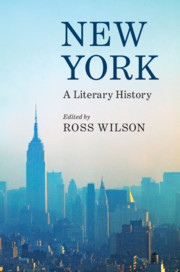Book contents
- New York: A Literary History
- New York
- Copyright page
- Contents
- Contributors
- Acknowledgements
- Chapter 1 Introduction
- Part I Adaptation and Adjustment
- Chapter 2 Changing Culture
- Chapter 3 Agitators and Intellectuals
- Chapter 4 The Mirror of the West
- Chapter 5 Writing the Big Apple in Chinese and Chinese American Literature
- Part II Innovation and Inspiration
- Part III Identity and Place
- Part IV Tragedy and Hope
- Bibliography
- Index
Chapter 5 - Writing the Big Apple in Chinese and Chinese American Literature
from Part I - Adaptation and Adjustment
Published online by Cambridge University Press: 19 February 2020
- New York: A Literary History
- New York
- Copyright page
- Contents
- Contributors
- Acknowledgements
- Chapter 1 Introduction
- Part I Adaptation and Adjustment
- Chapter 2 Changing Culture
- Chapter 3 Agitators and Intellectuals
- Chapter 4 The Mirror of the West
- Chapter 5 Writing the Big Apple in Chinese and Chinese American Literature
- Part II Innovation and Inspiration
- Part III Identity and Place
- Part IV Tragedy and Hope
- Bibliography
- Index
Summary
A history of the housed and the unhoused in New York literature still needs to be written. In this chapter, I turn the spotlight on two moments, the 1890s and the 1990s, which have both been framed as moments of specific urban crises: the Progressive Era and its housing reform movement; and the era of Reaganomics and its gentrification. In both moments, the development of capitalism in New York City had manufactured a sense of crisis that helped sanitize the city and discipline the poor. This was the goal of the housing reform movement when it framed the need to prevent a ‘spread’ of ‘pauperism’ from Downtown to the business, retail, and real estate districts beyond Washington Square; and that of Mayor Giuliani’s city, who removed the homeless to shelters at the city’s periphery in order to sanitize the city for global economy. Both of these moments have prompted a great productivity not only in journalism, sociology, political studies and the like, but also of narrative texts that conceptualise a city characterised through questions of social belonging, of the coexistence of the housed and the unhoused, and of the contingencies of concepts of ‘home’ and ‘homelessness.’
- Type
- Chapter
- Information
- New YorkA Literary History, pp. 61 - 76Publisher: Cambridge University PressPrint publication year: 2020



